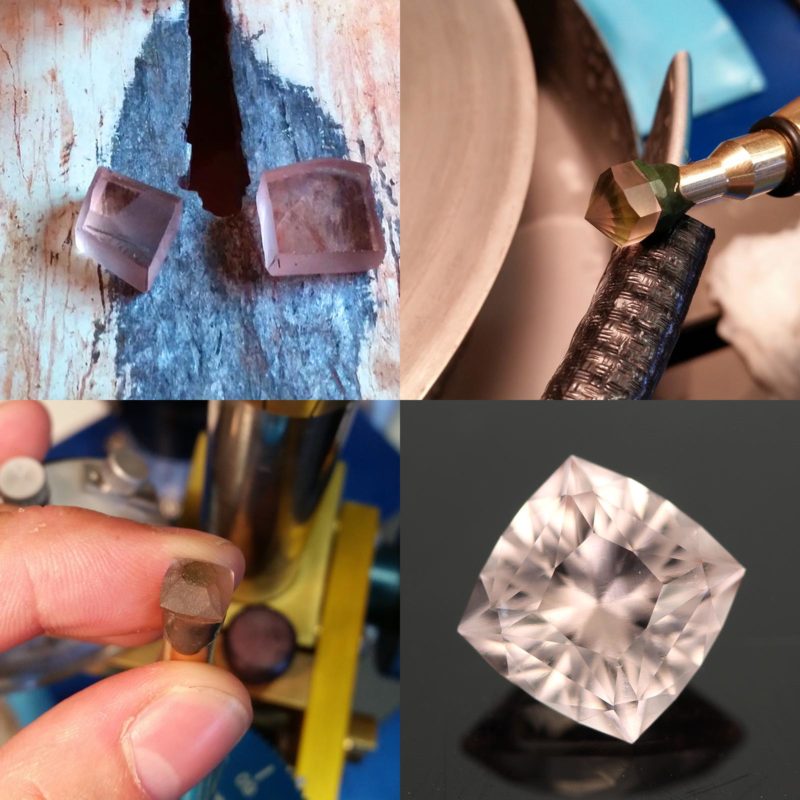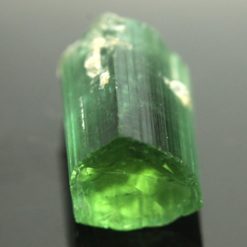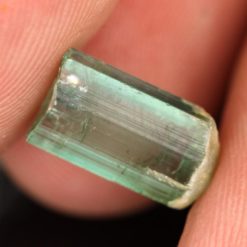No products in the cart.
Cutter's Desk
What is the Average Cutting Yield for Gemstone Faceting?
Gemstones as we know and recognize them have gone through a meticulous process before making their way to auctions and the gemstone marketplace. In fact, cut gemstones begin as rough specimens drawn from nature’s collection of sparkly treasures.
However, in their organic form, most rough specimens are mined in irregular shapes with plenty of flaws. Furthermore, rough gemstones may have fractures, cracks and color zoning to eliminate from the final cut. That’s why gem cutters have to skillfully facet rough stones into gemstones.
The process includes making important decisions that are specific to each and every rough specimen. Each has its own unique challenges. In order to retain a good portion of the original stone, the cutter needs to maximize the cut to minimize wasting excessive materials.
In this article, you’ll learn what to expect from gemstone faceting, including how much of the stone is usable, how much weight must be removed, what type of gems you might cut, and the styles of gemstone cutting.
What is Gemstone Faceting?
Gemstone faceting is a process used to cut the surfaces of stones such as emeralds, crystals and diamonds. The mechanics involve the angle of the cut, the rotation of the gemstone and how deep the stone is cut. Essentially, with these three processes and a faceting machine, a cutter can create a variety of gemstone cuts. However, in order to yield the greatest cut without wasting too much of the rough stone, certain factors must be addressed.

What is Maximum Yield?
The maximum yield of a gemstone facet is the weight retained for the actual stone. In order to yield the most of your cut, you want to start with a clean and cuttable stone. For example, if the rough specimen is not cut optimally, precious material is sacrificed. Alternatively, if the rough stone is analyzed and calculated for inclusions and shape, a cutter can garner a nicely sized stone that retains a good percentage of weight from the original stone. What factors influence the final size? Well, it’s important to know what size gem you need to begin with, or what size gem your customer prefers if you are creating a custom cut.
What Size Gem is Desired?
It’s important to know what kind of gem size is needed, because then you can determine how much of the stone to cut and keep. If you’re cutting a stone to pre-calibrated settings, you might yield a lower amount. That’s because calibrated settings fall within a certain margin according to the rough stone’s weight. If your rough stone is too small to fit into a larger margin, and must fall into a smaller setting. You might end up cutting away anywhere from ¼ to a whole carat. In these instances you’ll instead want to cut for the maximum yield.
This is especially smart when you are cutting a rather large or heavy piece of rough stone, because you’ll generally retain about 33% of the weight of the original specimen.
How Much Weight Must Be Removed?
It’s common to remove at least 10-20% of the stone in the first phases of cutting. This is because there are certain areas of the stone that are unusable. For example, fractures will need to be cut out. To approach this task requires calculating how much of the area surrounding the fracture needs to be removed. Moreover, how much does this portion weigh?
The percentage of the stone that needs to be removed will determine how much of the rough specimen can be faceted. Say 15% of the stone needs to be removed, is the remaining 85% optimal for cutting, or are there other fractures or features that also need to be removed?
A good strategy is to work with evenly shaped rough stones which make great canvases for cutting. That’s because if there are portions of the stone that need to be evened, then the faceting yield will be smaller.

What is the Average Cutting Yield for Gemstone Faceting?
Now that we’ve closely examined all of the key features that influence what a facet will yield, is there an average? Certainly. However, it depends on whether or not you are faceting according to maximum yield, a custom facet, or a factory calibrated setting.
Here are the reference points of what the average gemstone faceting yields:
- A custom cut will yield on average 25-35%
- A factory cut will yield 15-25%
What can we gather from these figures? It’s evident that a custom cut will yield a greater final weight. Here’s a quick summary of what to consider before you begin faceting a gemstone:
- Begin with an optimal rough stone that is clean and preferably flat or has minimal projections.
- Consider the size gem you need before you begin the process. Is the weight of the stone a candidate to fit within a calibrated setting, or should you instead cut for the maximum yield?
- Consult with your customer or client. If you’re faceting a custom setting then you need to consider your customer’s budget. If the gem is has an irregular size or shape, a custom setting will be more costly.
While faceting might seem complex initially, there are standards and schools to help you make the best decisions. Consider these factors to optimize the faceting yield, and minimize errors which can compromise the materials. Ultimately, a custom facet will yield more than a calibrated cut, however it all comes down to the shape and size of the stone you are working with, and the desired size of the gemstone. The final result will align directly with how you facet the rough stone.
What is the Best Case Scenario for Gemstone Faceting?
In some cases, you may be able to yield 40%, however you have to start with a large rough cut in order to get that percentage. For example, if you start with over 2 carats of rough stone, you’ll be fortunate to get a gorgeous 1-carat gemstone.







